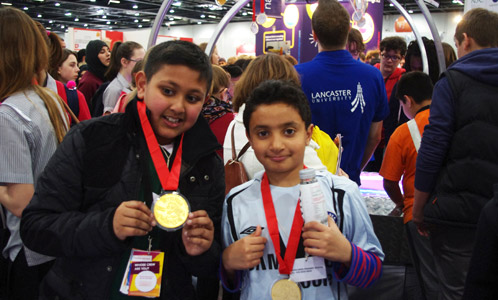Recent Stories
- Businesses urged to tap into science and technology young talent
- Digital relay baton enables remote crowd cheering of athletes
- Health Innovation Campus moves a step closer
- £7.1 million R&D boost for North West businesses
- Centre of excellence created for the next industrial revolution
- Artificial intelligence toolkit spots new child sexual abuse media online
- Strategic partnership set to help plug cyber security skills gap
- What your choice of smartphone says about you
- InfoLabTree: Discover the Story
- novi.digital Launch Event - 'An Event to Help Businesses Grow Online'
RSS Feeds
RSS feeds can deliver the latest InfoLab21 news and events direct to your browser without you having to visit the website.
In most browsers you can click on an RSS link and choose to subscribe to the feed to add it to your favourites or bookmarks.
Lancaster University a big hit at The Big Bang
 Experimenters who found the Higgs won a chocolate medal
Experimenters who found the Higgs won a chocolate medal
Lancaster University's interactive particle physics exhibit, manned by a team of Science and Technology students and researchers, proved to be a big hit at this year's Big Bang Science Fair.
Lancaster's Physics Department helped design the interactive virtual particle accelerator game, based on the science behind the ATLAS project at CERN's Large Hadron Collider (LHC).
Visitors to the Big Bang played a game simulating experiments that took place in the hunt for the Higgs boson, with over a thousand Higgs finders taking away special Lancaster University chocolate 'Nobel Prize' medals.
The Big Bang Fair, aimed at 7-19 year-olds, attracted over 60,000 aspiring scientists and engineers. Lancaster Physicist Professor Jim Wild was very pleased by the reaction to Lancaster's interactive exhibit: "Our game proved to be massively popular, with kids crowding three deep at times to get a chance to play!"
The game is based on the expertise of Lancaster's particle physicists, who have first-hand experience of working on the search for the Higgs boson. It was designed and made by John Hardy, a research student from lancaster's School of Computing and Communications, with technical support from the Engineering Department.
Funding for the interactive exhibit came from the Faculty of Science and Technology and the Lancaster University Friends Programme.
Dr Alan Darragh, who co-ordinated Lancaster University's trip to the Big Bang, was delighted with the response from visitors to the Big Bang to the hands-on exhibit: "It was great to see people from across our faculty coming together to find a really exciting way to showcase science and technology."
Building the 'Particle Accelerator'
Lancaster's virtual particle accelerator uses an Xbox Kinect motion sensor and a digital projector to create an interactive table-top display. See how it was made:
Thu 21 March 2013



